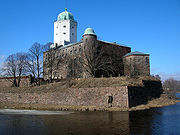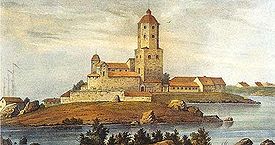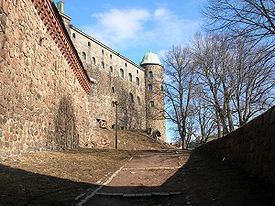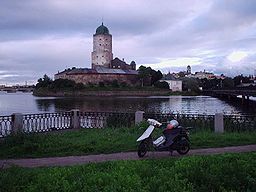
Vyborg (castle)
Encyclopedia

Sweden
Sweden , officially the Kingdom of Sweden , is a Nordic country on the Scandinavian Peninsula in Northern Europe. Sweden borders with Norway and Finland and is connected to Denmark by a bridge-tunnel across the Öresund....
built medieval fortress around which the town of Viborg
Viborg
Viborg may refer to:*Viborg, Denmark, a city in Jutland, Denmark**Viborg Municipality, a Danish municipality named for the city**Viborg County, a former county of Denmark**Diocese of Viborg**Viborg FF, a professional football team based in Viborg...
, today in Russia
Russia
Russia or , officially known as both Russia and the Russian Federation , is a country in northern Eurasia. It is a federal semi-presidential republic, comprising 83 federal subjects...
evolved. Currently it is a museum.
General
Viborg Castle was one of the three major castles of FinlandFinland
Finland , officially the Republic of Finland, is a Nordic country situated in the Fennoscandian region of Northern Europe. It is bordered by Sweden in the west, Norway in the north and Russia in the east, while Estonia lies to its south across the Gulf of Finland.Around 5.4 million people reside...
. It was built as the easternmost outpost of the medieval Kingdom of Sweden
Sweden-Finland
Sweden–Finland is an outdated Finnish historiographical term referring to the Swedish Kingdom from the Kalmar Union to the Napoleonic wars, or the period from the 14th to the 18th century. In 1809 the realm was split and the eastern half came to constitute the autonomous Grand Duchy of Finland, in...
: it is located on the Karelian isthmus
Karelian Isthmus
The Karelian Isthmus is the approximately 45–110 km wide stretch of land, situated between the Gulf of Finland and Lake Ladoga in northwestern Russia, to the north of the River Neva . Its northwestern boundary is the relatively narrow area between the Bay of Vyborg and Lake Ladoga...
, on a little islet in the innermost corner of the Gulf of Finland
Gulf of Finland
The Gulf of Finland is the easternmost arm of the Baltic Sea. It extends between Finland and Estonia all the way to Saint Petersburg in Russia, where the river Neva drains into it. Other major cities around the gulf include Helsinki and Tallinn...
, in a tight strait which connects Suomenvedenpohja
Suomenvedenpohja
Zashchitnaya Bay is an end of Vyborg Bay in present-day Russian Federation in the City of Vyborg in the Leningrad Oblast. The Vyborg Bay is itself a bay of the Gulf of Finland in the Baltic Sea. The Castle of Vyborg is located by it. Also the Park Monrepos is located by Zashchitnaya Bay...
to Bay of Viipuri. It was originally constructed in the 1290s.
The town was originally located inside the outer fortifications of the castle, at the fortress island, but it had to be moved to its present location out of the island because of lack of space.
Medieval history



Torkel Knutsson
Torkel Knutsson, known well as Marshal Torkel, of Aranäs, was constable and virtual ruler of Sweden during the early reign of King Birger Magnusson ....
, the Lord High Constable of Sweden
Lord High Constable of Sweden
The Lord High Constable was a prominent and influential office in Sweden, from the 13th century until 1676, excluding periods when the office was out of use. The office holder was a member of the Swedish Privy Council and, from 1630 and on, the head of the Swedish Council of War...
who made in 1290s a so-called crusade to Karelia
Karelia
Karelia , the land of the Karelian peoples, is an area in Northern Europe of historical significance for Finland, Russia, and Sweden...
, the so-called Third Finnish Crusade
Swedish-Novgorodian Wars
Swedish–Novgorodian Wars were a series of conflicts in the 12th and 13th centuries between the Republic of Novgorod and medieval Sweden over control of the Gulf of Finland, an area vital to the Hanseatic League and part of the Varangian-Byzantine trade route...
, actually aimed against Russians, i.e. Novgorod. He chose the location of the new fortress to keep the Bay of Vyborg, which was a trading site used by locals already for a long time. From the bay, a river way goes inland, ultimately connecting the place to several districts, lakes, and indirectly also to rivers going to Ladoga.
The three high-medieval Finnish "castle fiefs" were ruled from the castles of Turku
Turku
Turku is a city situated on the southwest coast of Finland at the mouth of the Aura River. It is located in the region of Finland Proper. It is believed that Turku came into existence during the end of the 13th century which makes it the oldest city in Finland...
, Hämeenlinna
Hämeenlinna
Hämeenlinna is a city and municipality of about inhabitants in the heart of the historical province of Häme in the south of Finland and is the birthplace of composer Jean Sibelius. Today, it belongs to the region of Tavastia Proper, and until 2010 it was the residence city for the Governor of the...
and Viipuri, respectively until the 1360s.
In 1366, Albert III of Mecklenburg was elected king, and according to the German model he began to divide up the castle fiefs, which were immense in Finland, into smaller provinces. In some cases, these new, smaller provinces were given separate bailiff
Bailiff
A bailiff is a governor or custodian ; a legal officer to whom some degree of authority, care or jurisdiction is committed...
s' residences which have since disappeared; this was the case with the Linnavuori castle mound in Porvoo
Porvoo
Porvoo is a city and a municipality situated on the southern coast of Finland approximately east of Helsinki. Porvoo is one of the six medieval towns in Finland, first mentioned as a city in texts from 14th century...
and the castle of Korsholm
Korsholm Castle
Korsholma Castle was a medieval castle in Vaasa, Finland. It was probably built in the 1370s. Today a low mound is all that remains of the castle.-References:...
in Ostrobothnia
Ostrobothnia (historical province)
Ostrobothnia, and , is a historical province of Finland to the west and north in Finland. It borders on Karelia, Savonia, Tavastia and Satakunda in the south, and on Västerbotten in Sweden, and Laponia in the north...
, near the today city of Vaasa
Vaasa
Vaasa is a city on the west coast of Finland. It received its charter in 1606, during the reign of Charles IX of Sweden and is named after the Royal House of Vasa...
which was founded later. Only earthworks remain at these sites, but in two places, stone strongholds were built which still exist, although in ruins. One is Raseborg Castle in western Uusimaa (west of Helsinki
Helsinki
Helsinki is the capital and largest city in Finland. It is in the region of Uusimaa, located in southern Finland, on the shore of the Gulf of Finland, an arm of the Baltic Sea. The population of the city of Helsinki is , making it by far the most populous municipality in Finland. Helsinki is...
), the other Kastelholm castle in the Åland (Ahvenanmaa) islands
The castle became the stronghold of the Swedish realm in Karelian regions. Throughout the centuries, it was the first defence of the kingdom against Russians. Its military and strategic status was in the late Middle Ages only second to the fortified capital Stockholm
Stockholm
Stockholm is the capital and the largest city of Sweden and constitutes the most populated urban area in Scandinavia. Stockholm is the most populous city in Sweden, with a population of 851,155 in the municipality , 1.37 million in the urban area , and around 2.1 million in the metropolitan area...
.
The castle and the large surrounding fief became a virtually autonomous principality
Principality
A principality is a monarchical feudatory or sovereign state, ruled or reigned over by a monarch with the title of prince or princess, or by a monarch with another title within the generic use of the term prince....
. Its governors were usually fiefed with the incomes of the county. The fief of Viborg
Fief of Viborg
Fief of Viborg or Margraviate of Wiburg 1320-1534, was for some two centuries a late medieval feudal fief in the southeastern border of Finland and the entire Swedish realm, held by its chatelain, a fiefed, appointed feudal lord....
became known as a margraviate. Its governors were generally from the most powerful families of the kingdom. They enjoyed large administrative powers and a good distance from the capital. Those realities made them practically independent rulers. Usually, the castle of Olavinlinna
Olavinlinna
Olavinlinna is a 15th century three-tower castle located in Savonlinna, Finland. It is the northernmost medieval stone fortress still standing.- Construction :...
(built in 1470s) was subjugated to Viipuri.
Prominent figures who held Viipuri as their fief, were Bo Jonsson Grip, Christer Nilsson Vasa (1417–42), Karl Knutsson Bonde (1442–48, the future king), Eric Axelsson Tott (1457–81), Knut Posse
Knut Posse
Knut Jönsson Posse was a Swedish general remembered for his surprise attack on the Danish Army at the Battle of Brunkeberg . Some sources claim the wounds were mortal, but he lived until March 25, 1500.- Military career :...
(1495–97), Sten Sture the Elder
Sten Sture the Elder
Sten Sture the Elder was a Swedish statesman and regent of Sweden from .-Background:...
(1497–99, between his regencies), Eric Bielke
Eric Bielke
Eric Bielke , also known as Eerikki Tuurenpoika and Eric Tureson, royal councillor of Sweden, knighted, feudal fiefholder of Vyborg castle .-Biography:...
and count John of Hoya. Particularly in 1440s and in late 15th century, the fortresses were further enlarged.
The first mention of firearms in Finland relates to Viborg castle, in 1429. During the Middle Ages the castle was repeatedly besieged by the Russians, most famously in 1495, during the Russo-Swedish War (1495–1497). Governor Knut Posse was in office 1495-1497. The situation of the defenders looked hopeless, but they were saved by the Viborg blast on 30 November 1495, a mysterious explosion which scared off the Russians because they reportedly saw a St. Andrew's cross in the sky.
Modern history

Viipuri was taken by the Russians in 1710, but passed back to Finnish hands in 1812 when all of Old Finland
Old Finland
thumb|right|260px|The areas that Sweden lost to Russia in the wars of 1721 and 1743Old Finland is a name used for the areas that Russia gained from Sweden in the Great Northern War and in the Russo-Swedish War...
was attached to the autonomous Grand Duchy of Finland
Grand Duchy of Finland
The Grand Duchy of Finland was the predecessor state of modern Finland. It existed 1809–1917 as part of the Russian Empire and was ruled by the Russian czar as Grand Prince.- History :...
. The castle owes its present appearance to extensive restorations undertaken in the 1890s. The military of the Russian Empire
Russian Empire
The Russian Empire was a state that existed from 1721 until the Russian Revolution of 1917. It was the successor to the Tsardom of Russia and the predecessor of the Soviet Union...
used the castle until 1918 for housing administration.
Viipuri belonged to the independent Republic of Finland between 1917–1940 and again 1941-1944. As a result of border changes
Karelian question in Finnish politics
The Karelian question or Karelian issue is a dispute of Finnish politics over whether or not to try to regain sovereignty over the Finnish Karelia and other territories ceded to the Soviet Union in the Winter War and the Continuation War...
in World War II
World War II
World War II, or the Second World War , was a global conflict lasting from 1939 to 1945, involving most of the world's nations—including all of the great powers—eventually forming two opposing military alliances: the Allies and the Axis...
it was annexed by Russia in 1944.
Architecture
The main castle, located in the eastern part of the islet on its highest hill, has an irregular four-cornered layout, with the immense tower of St. OlavTower of St. Olav
The Tower of St. Olav is the one remaining tower of Vyborg Castle. It is a symbol and an architectural landmark of the city of Vyborg.- History :...
(Pyhän Olavin torni in Finnish) as its biggest section. It is 3-4 stories tall, varying in places. Outer defensive works surround the main castle, following the islet's coastlines.

